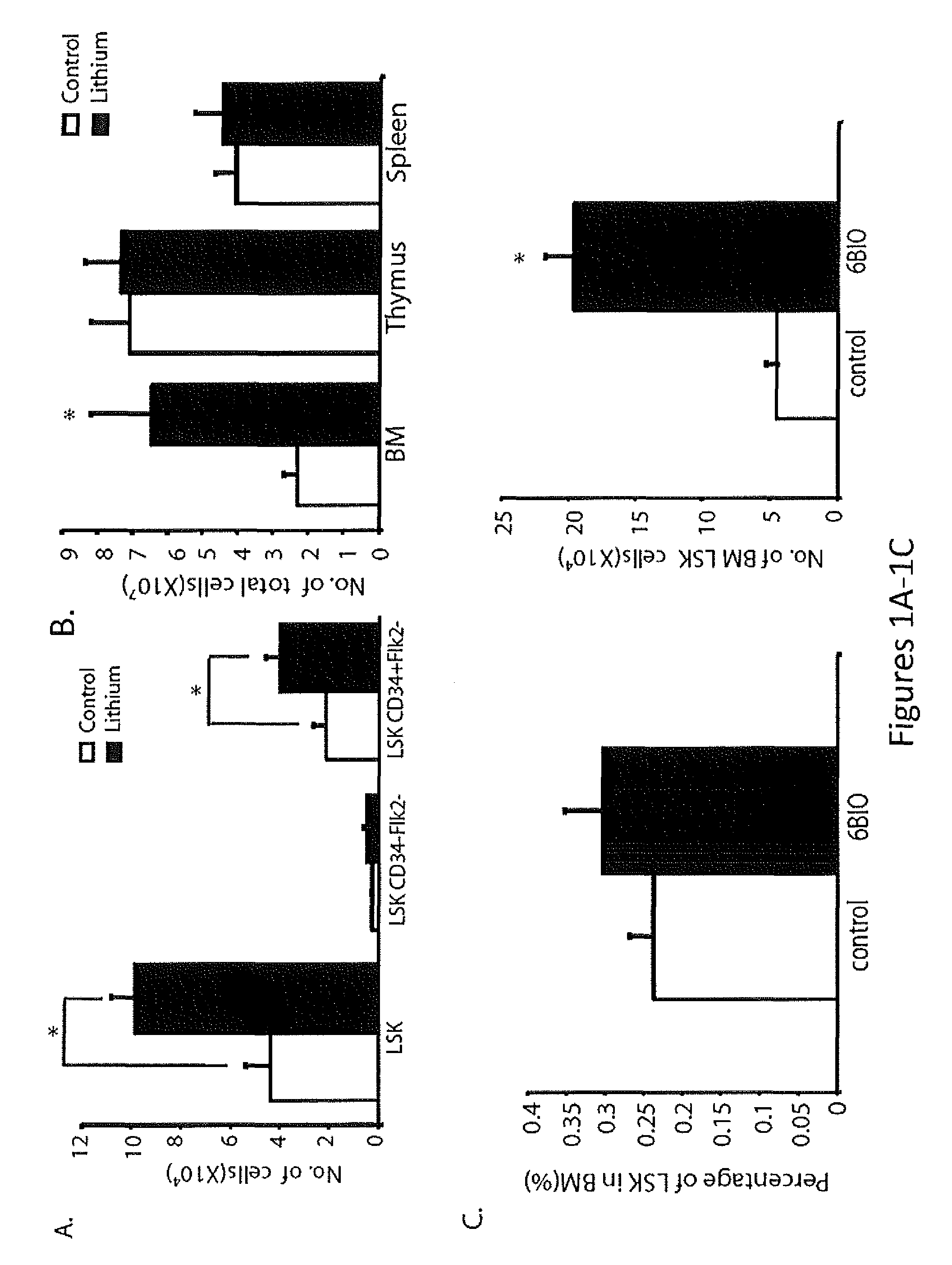In vivo and ex vivo expansion of hematopoietic stem cells with a targeted combination of clinically tested, FDA approved drugs
a technology of hematopoietic stem cells and fda approved drugs, which is applied in the direction of drug composition, extracellular fluid disorder, genetically modified cells, etc., can solve the complex signaling network regulating the balance between hsc self-renewal and differentiation, which has not previously been performed, and the loss of gsk-3 function in hscs
- Summary
- Abstract
- Description
- Claims
- Application Information
AI Technical Summary
Benefits of technology
Problems solved by technology
Method used
Image
Examples
example 1
Lithium Increases Hematopoietic Stem / Progenitor Cells
[0114]Lithium increases circulating CD34+ stem cells (Bailin, et al., 1998, Br J Haematol 100:219-221) in humans, increases neutrophil count in a high percentage of treated patients, and may also stimulate other lineages (Shopsin, et al., 1971, Clin Pharmacol Ther 12:923-928; Boggs, et al., 1983, Seminars in Hematology 20:129-138; Barr, et al., 1983, Canadian Medical Association Journal 128:123-126; Tisman, et al., 1972, British Journal of Haematology 24:767-771; Joyce, 1984, British Journal of Haematology 56:307-321; Bille, et al., 1975, Acta Medica Scandinavica 198:281-286; Ricci, et al., 1981, Haematologica 66:627-633; Focosi, et al., 2009, Journal of Leukocyte Biology 85:20-28). In rodents, lithium increases peripheral blood counts and enhances stem and progenitor cell numbers in ex vivo and in vivo assays. These studies led to the hypothesis that the effects of lithium are mediated at the level of the HSC and / or HPC (Joyce, 1...
example 2
GSK-3 as the Target of Lithium in HSC / HPCs
[0116]Inhibition of GSK-3 provides a compelling explanation for many of the known effects of lithium (Klein, et al., 1996, Proc. Nat'l. Acad. Sci. U.S.A. 93:8455-8459), but lithium also inhibits inositol monophosphatase and structurally related phosphomonoesterases, some of which are highly sensitive to lithium (Gurvich et al., 2002, Pharmacol Ther 96:45-66). To test further whether inhibition of GSK-3 explains the hematopoietic effects of lithium, selective GSK-3 inhibitors were used that are unlikely to have off-target effects that overlap with lithium (Bain, et al., 2003, Biochem J 371 (Pt. 0:199-204; Meijer, et al., 2003, Chem Biol 10:1255-1266; Williams, et al., 2005, Angew Chem Int Ed Engl. 44:1984-1987). The selective GSK-3 inhibitor, 6-bromo-indirubin 3′-oxime (6BIO) has an 1050 for GSK-3 in the nanomolar range (Meijer, et al., 2003, Chem Biol 10:1255-1266). 6BIO caused a pronounced increase in the number of LSK cells after a 2-week ...
example 3
Gsk-3 Loss of Function in Hematopoietic Cells
[0119]Therapeutic lithium increases the number of circulating CD34+ stem cells in humans (Ballin, et al., 1998, Br. J. Haematol. 100:219-221), increases peripheral blood counts, especially neutrophils, in a high percentage of treated patients, and enhances stem and progenitor cell numbers in rodents (Boggs, et al., 1983, Semin. Hematol. 20:129-138; Joyce, 1984, Br. J. Haematol. 56:307-321; Ricci, et al., 1981, Haematologica. 66:627-633; Focosi, et al., 2009, J. Leukoc. Biol. 85:20-28; Gallicchio, et al., 1992, J. Med. 23:195-216; Gallicchio, et al., 1980, Blood. 56:1150-1152). However, since these early studies were performed, immunophenotypic markers of HSCs and HPCs have become available (Purton, et al., 2007, Cell Stem Cell. 1:263-270). Flow cytometry (FCM) on BM from lithium-treated mice were used, and an increase in immunophenotypic HSCs / HPCs was found, as detected by LSK markers (Purton, et al., 2007, Cell Stem Cell. 1:263-270; See ...
PUM
| Property | Measurement | Unit |
|---|---|---|
| total volume | aaaaa | aaaaa |
| frequencies | aaaaa | aaaaa |
| phospho-GSK-3α/β | aaaaa | aaaaa |
Abstract
Description
Claims
Application Information
 Login to View More
Login to View More - R&D
- Intellectual Property
- Life Sciences
- Materials
- Tech Scout
- Unparalleled Data Quality
- Higher Quality Content
- 60% Fewer Hallucinations
Browse by: Latest US Patents, China's latest patents, Technical Efficacy Thesaurus, Application Domain, Technology Topic, Popular Technical Reports.
© 2025 PatSnap. All rights reserved.Legal|Privacy policy|Modern Slavery Act Transparency Statement|Sitemap|About US| Contact US: help@patsnap.com



